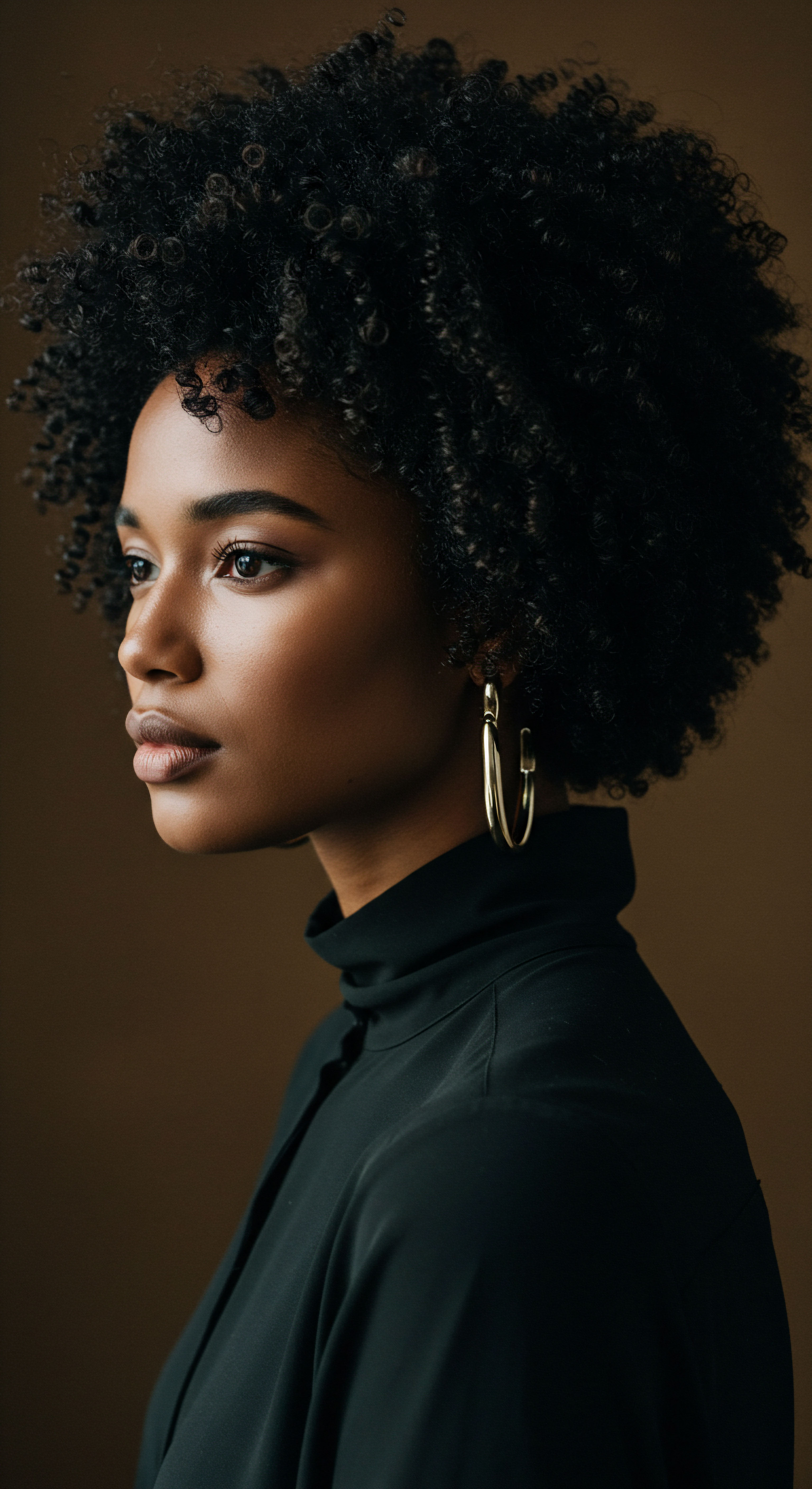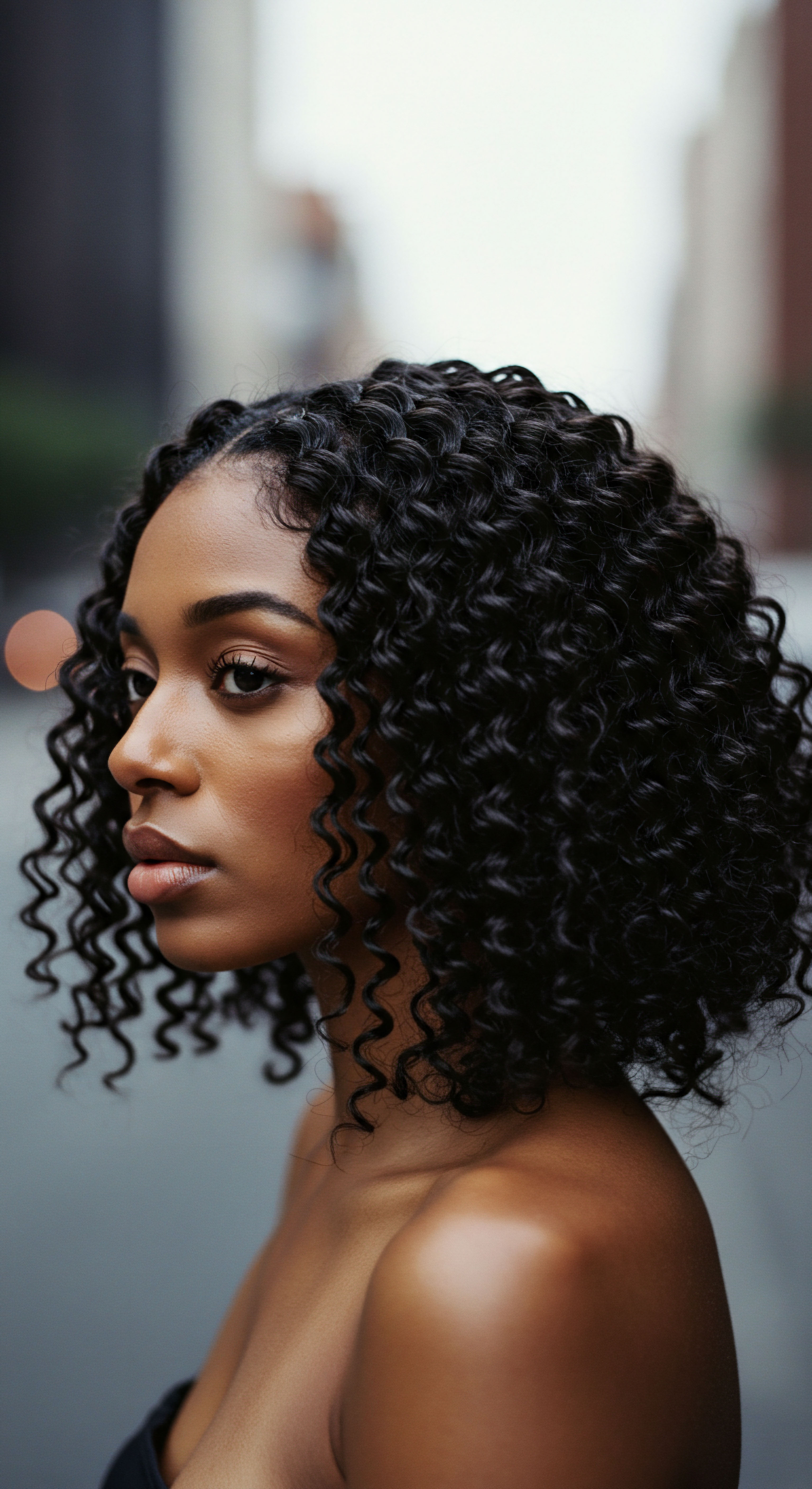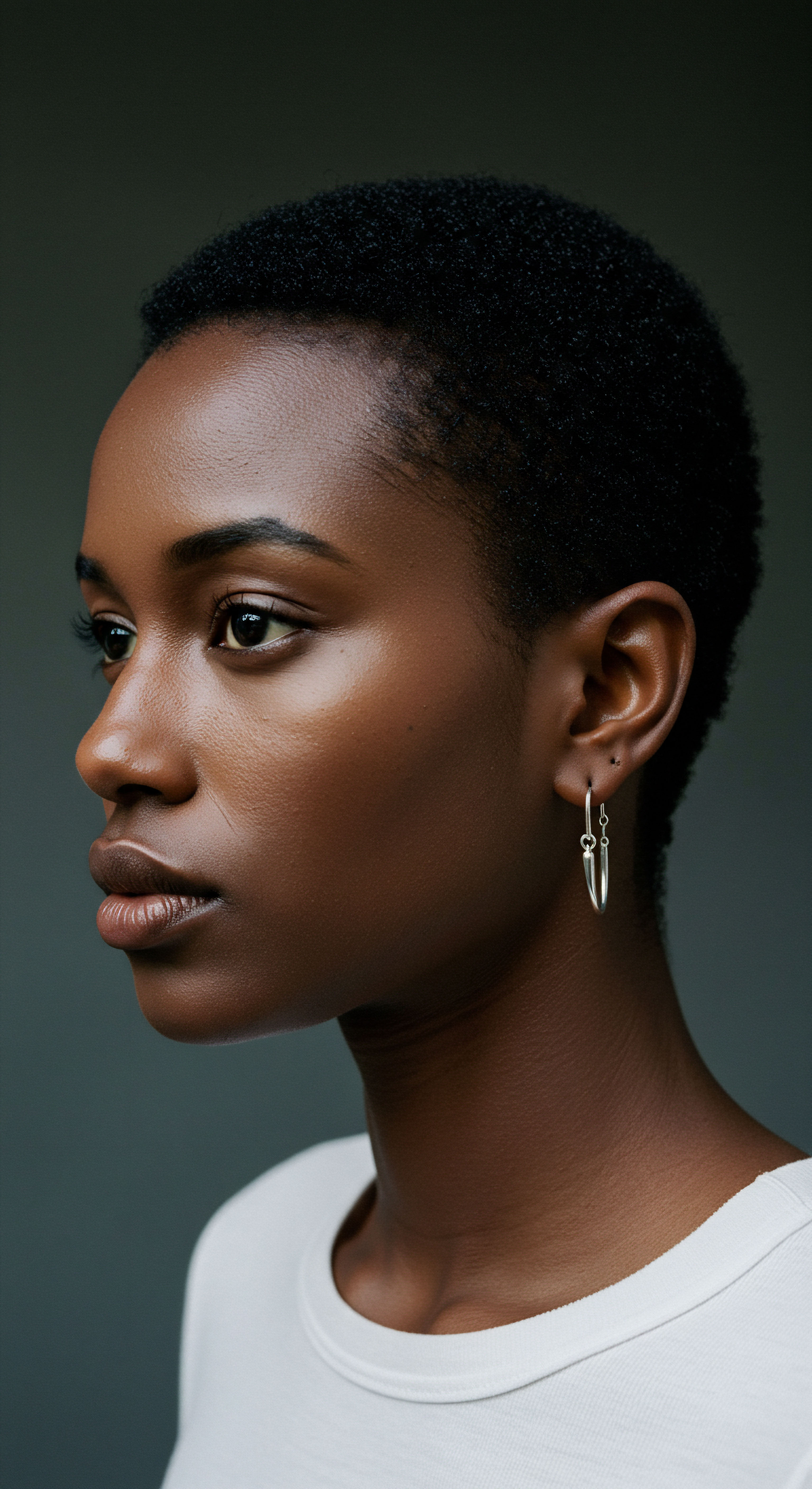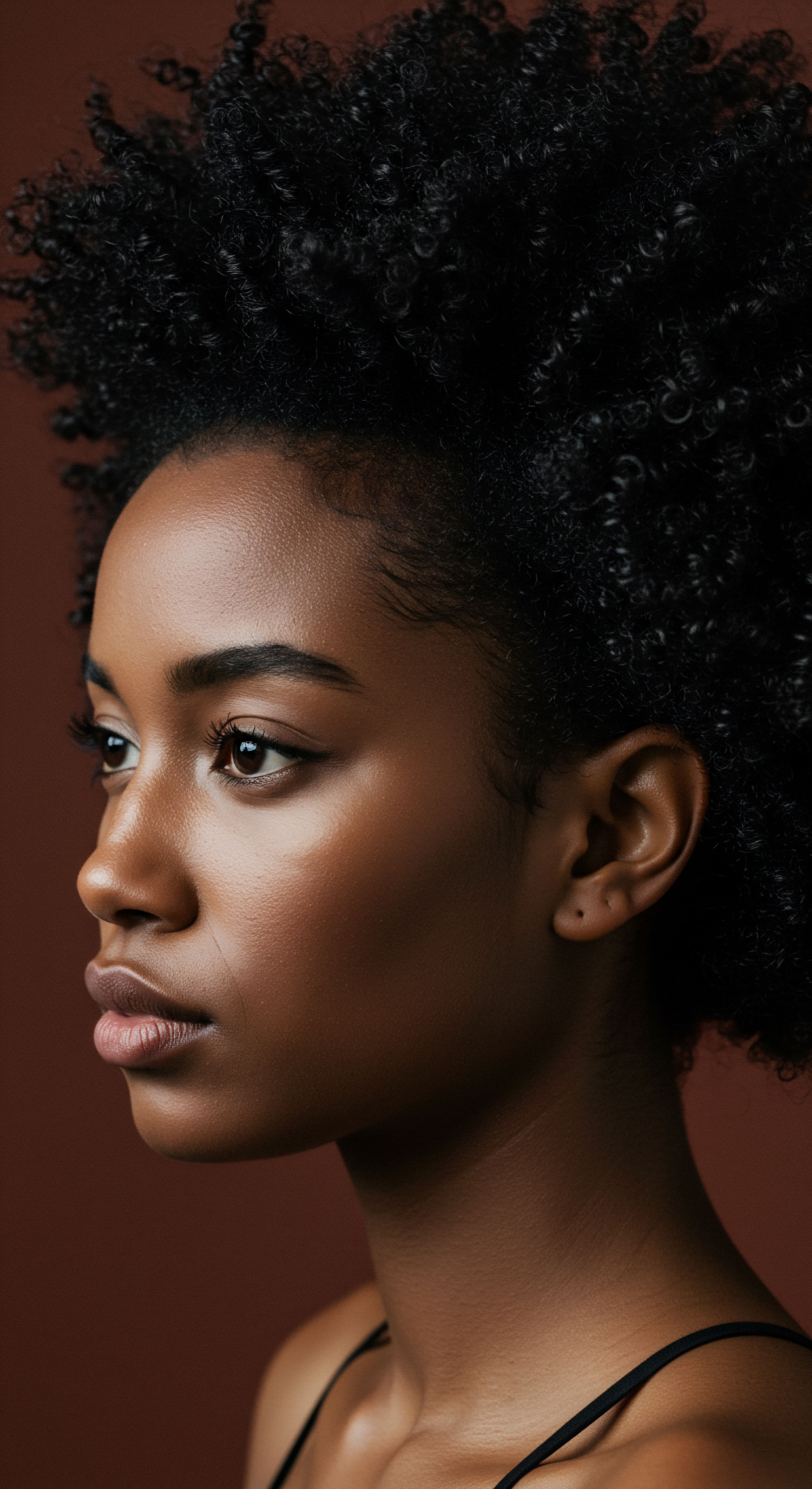
Roots
A quiet morning often begins with a whisper of moisture in the air, a gentle suggestion of the day’s unfolding. For those with low porosity textured hair, this whisper can quickly swell into a profound conversation with the very atmosphere, a dialogue sometimes fraught with misunderstanding. Why does this particular hair type, with its inherent resilience and beauty, find itself in such a delicate dance with humidity?
To truly grasp this interplay, we must journey to the very foundations of the hair strand, delving into its intimate architecture and the silent mechanisms that govern its interaction with the world around it. This is not merely about frizz; it is about the fundamental nature of hair itself, a story told at a microscopic level, where science meets lived experience.

Hair Cuticle Architecture and Moisture Resistance
The outermost layer of each hair strand, the cuticle, acts as a protective shield. For low porosity hair, these cuticle scales lie remarkably flat and compact, much like tightly sealed shingles on a roof. This dense arrangement presents a formidable barrier, making it inherently resistant to the easy absorption of external moisture.
While this characteristic offers a measure of protection against environmental stressors, it simultaneously poses a significant challenge when the surrounding air carries an abundance of water vapor. The very structure designed for defense becomes a gatekeeper, reluctant to allow hydrating elements in.
Low porosity hair’s tightly sealed cuticle creates a natural barrier, making it resistant to moisture absorption and presenting unique challenges in humid conditions.
The surface of the cuticle is also coated with a specialized lipid layer, primarily composed of 18-methyleicosanoic acid (18-MEA), which is covalently bound to the epicuticle. This lipid layer contributes significantly to the hair’s hydrophobic nature, further repelling water. In low porosity hair, this natural hydrophobic coating, combined with the tightly packed cuticle, forms a highly effective barrier against water penetration. This means that while high humidity saturates the air, the hair struggles to draw in beneficial moisture, leading to a feeling of dryness even amidst dampness.

Hydrophobic Nature of Low Porosity Hair
The inherent hydrophobicity of low porosity hair stems from both its structural protein arrangement and its lipid composition. Keratin, the primary protein building block of hair, possesses a complex structure with various amino acid side chains. While hair as a whole is hygroscopic, meaning it can absorb moisture, the specific arrangement of keratin and the presence of surface lipids in low porosity hair dictate a slower, more reluctant absorption rate. This leads to a phenomenon where water beads on the surface rather than quickly permeating the strand.
Consider the subtle differences in lipid distribution across various hair types. Research indicates that while Afro-textured hair often possesses a higher overall lipid content, these lipids can be more disordered, influencing water dynamics. This subtle disarray, when combined with a low porosity cuticle, can create a paradoxical situation where the hair is rich in lipids yet still struggles with proper hydration from external sources, particularly in a humid environment. The lipids, instead of facilitating absorption, contribute to the surface repellency.
- Cuticle Density ❉ The close alignment of cuticle scales forms a robust shield, impeding the swift passage of water molecules.
- Lipid Layer ❉ A naturally occurring hydrophobic coating on the hair’s surface further enhances its water-repellent qualities.
- Keratin Arrangement ❉ The internal protein structure contributes to the hair’s general resistance to rapid moisture uptake.

The Role of Keratin Bonds
Within the hair’s cortex, beneath the cuticle, lie keratin filaments held together by various bonds, including hydrogen bonds and disulfide bonds. Hydrogen bonds are particularly susceptible to water; they break in the presence of moisture, allowing the hair to stretch and alter its shape. In low porosity hair, while the external cuticle resists water entry, if humidity eventually permeates, these internal bonds can be affected, leading to changes in curl pattern and potential swelling. This internal response, however, is delayed and often uneven due to the initial barrier.
The unique helical shape and flattened elliptical cross-section of textured hair, particularly Afro-textured hair, mean that the internal keratin protein packing can be less uniform. This unevenness, coupled with the tightly bound cuticle, can contribute to the hair’s distinctive response to atmospheric moisture. When water eventually enters, it may do so unevenly, causing some areas to swell more than others, which can disrupt the natural curl pattern and contribute to a frizzy appearance.

Ritual
Stepping from the quiet contemplation of hair’s inner workings, we arrive at the rhythm of daily life, where our hands meet our strands in gestures of care. For those navigating the unique qualities of low porosity textured hair, particularly when confronted by humidity, the practical wisdom of ritual becomes paramount. This section invites a closer look at the intentional practices and choices that can transform a challenging atmospheric condition into an opportunity for balanced beauty. It is about understanding how our routines can harmonize with our hair’s distinct needs, moving beyond simple application to a thoughtful, purposeful engagement with our strands.

Cleansing Rituals and Product Buildup
The tightly packed cuticle of low porosity hair, while protective, also presents a challenge for product absorption. Products tend to sit on the surface, leading to rapid buildup if not properly addressed. This surface accumulation can paradoxically create a barrier, preventing even more moisture from penetrating the hair shaft, exacerbating dryness in humid conditions. Therefore, a thoughtful cleansing ritual is foundational.
Regular use of a gentle clarifying shampoo is not merely an option; it is a necessity for low porosity hair. Such shampoos help remove residue without stripping the hair of its natural oils. This allows subsequent hydrating products a clearer path to the hair shaft.
For instance, studies on hair porosity measurement using gas adsorption and pore size analysis indicate that damaged hair, which tends to be more porous, has a higher surface area. While low porosity hair is the opposite, effective cleansing ensures its surface is optimally prepared to receive the limited moisture it does absorb.
| Aspect Shampoo Type |
| Low Porosity Hair Needs Gentle clarifying, sulfate-free formulations |
| Aspect Frequency |
| Low Porosity Hair Needs Regular, to prevent product accumulation |
| Aspect Water Temperature |
| Low Porosity Hair Needs Warm water to help gently lift cuticle scales |
| Aspect Proper cleansing sets the stage for effective hydration. |

Conditioning Practices and Moisture Infusion
After cleansing, the conditioning step for low porosity hair requires particular attention. Given the cuticle’s resistance, simply applying conditioner may not yield desired results. Heat, in the form of a steamer or a heated conditioning cap, can gently lift the cuticle scales, allowing conditioning agents to penetrate more effectively. This thermal assistance transforms a superficial application into a deeper, more impactful treatment.
Applying conditioners with gentle heat can help low porosity hair absorb moisture more deeply, moving beyond surface-level conditioning.
Selecting conditioners with lightweight, water-attracting ingredients is crucial. Ingredients like glycerin, honey, aloe vera, and hyaluronic acid are humectants that draw moisture from the air and bind it to the hair. However, a nuanced understanding is vital ❉ in extremely high humidity, too many humectants can sometimes pull excessive moisture into the hair, leading to undesirable swelling and frizz. This is where the balance of ritual becomes a finely tuned art.
- Humectant Use ❉ Choose products with humectants, but adjust usage in very high humidity to prevent oversaturation.
- Heat Application ❉ Utilize steam or heated caps to aid deeper penetration of conditioning treatments.
- Lightweight Formulations ❉ Prioritize conditioners that do not contain heavy butters or oils that could cause buildup.

Styling for Humid Climates
When humidity looms, styling low porosity textured hair calls for strategies that respect its unique properties. The goal is to seal in the moisture already present and minimize the hair’s interaction with the atmospheric dampness. This often involves using products that form a protective barrier without creating a heavy, suffocating film.
Consider the “LOC” or “LCO” methods (Liquid, Oil, Cream / Liquid, Cream, Oil) for sealing moisture. For low porosity hair, the emphasis should be on lighter oils and creams that can actually penetrate or provide a gentle seal, rather than simply sitting on the surface. Lightweight oils such as grapeseed, argan, sweet almond, or jojoba are often recommended, as their smaller molecules are more likely to permeate the hair shaft. Heavy oils like castor or coconut oil, while beneficial for other hair types, can sometimes be too occlusive for low porosity strands, leading to buildup and a greasy feel without providing internal hydration.
Furthermore, protective styles can serve as a practical defense against humidity’s effects. Styles that keep the hair tucked away, such as buns, braids, or twists, can reduce the surface area exposed to the humid air, thereby minimizing swelling and frizz. This not only preserves the style but also helps maintain the hair’s internal moisture balance.

Product Chemistry and Hair’s Response
The chemical composition of hair products plays a decisive role in how low porosity hair responds to humidity. Products containing certain silicones, particularly non-water-soluble varieties, can coat the hair and create a barrier that prevents moisture from entering. While this might seem beneficial in high humidity to prevent frizz, it can also trap dryness within the hair or lead to undesirable buildup over time. Opting for water-soluble silicones or silicone-free alternatives can offer more flexibility.
Protein treatments, when selected carefully, can also play a role. Low molecular weight proteins, such as hydrolyzed keratin, hydrolyzed wheat protein, or silk amino acids, are small enough to penetrate the hair shaft, providing internal strength without causing stiffness or buildup. These can support the hair’s structure, making it less prone to collapse or frizz when faced with humidity, as they reinforce the hair’s natural protein framework.

Relay
Beyond the visible texture and the familiar rituals, a deeper current flows through the experience of low porosity textured hair in humidity, connecting us to environmental forces, cultural narratives, and the very subtle physics of our strands. This section beckons us to consider the less obvious, yet profoundly impactful, layers of this interaction. It is an invitation to view the challenge not in isolation, but as a complex interplay of biology, climate, and the human story, revealing insights that might reshape our understanding and care.

Environmental Thermodynamics and Hair’s Hygroscopy
Hair is inherently hygroscopic, meaning it readily absorbs moisture from the air. This property is governed by the hair fiber’s rich content of hydrophilic groups within its keratin proteins. When relative humidity increases, hair fibers swell; studies show that hair can increase its diameter by almost 14% when relative humidity reaches 100%.
For low porosity hair, this process is not necessarily prevented, but rather slowed and potentially uneven. The tightly bound cuticle acts as a gatekeeper, but if the external environment persists in its dampness, moisture will eventually find its way in.
The challenge for low porosity hair in humidity stems from a complex thermodynamic dance. The hair’s tightly sealed cuticle initially resists water vapor. However, when the external vapor pressure is significantly higher than the internal moisture content of the hair, a gradient is established. Water molecules, driven by this gradient, will eventually attempt to move into the hair shaft.
Because the cuticle is so resistant, this absorption can be slow and uneven, leading to strands that feel heavy, lose their definition, or frizz as some areas swell while others remain resistant. The hair struggles to reach an equilibrium with the humid air gracefully.
The tightly bound cuticle of low porosity hair slows, but does not entirely prevent, the absorption of atmospheric moisture, leading to uneven swelling and styling challenges in high humidity.
A compelling study highlights the nuanced relationship between hair lipids and water dynamics, particularly across different ethnic hair types. Research by IQAC-CSIC and ALBA Synchrotron demonstrated that African hair, despite having a higher overall lipid content, exhibits more disordered lipids. This finding is counterintuitive to the common assumption that more lipids equate to better moisture retention or less swelling. Instead, this disordered lipid arrangement can contribute to the hair’s unique interaction with water, potentially explaining why low porosity textured hair, even with its protective cuticle, can still experience significant swelling and changes in structure in humid conditions.
The lipid barrier is not perfectly impermeable, and its specific organization influences how water interacts with the cuticle surface and eventually the cortex. This suggests that the quality and arrangement of lipids, not just their quantity, play a critical role in how hair responds to humidity.

Cultural Hair Practices and Environmental Adaptation
Throughout history, hair has held profound cultural significance, often reflecting identity, social status, and spiritual beliefs. Traditional hair practices, particularly within communities with textured hair, have often evolved as a response to local environmental conditions, including humidity. For generations, techniques of braiding, twisting, and coiling served not only as artistic expressions but also as practical methods to manage hair in varying climates.
Consider the deep historical roots of protective styling. Many ancestral practices involved manipulating hair into configurations that minimized exposure to harsh elements, including excessive moisture or dryness. These styles, often passed down through families, implicitly recognized the hair’s delicate balance with its environment.
While modern science now provides detailed explanations for porosity and humidity’s effects, these cultural rituals were often born from centuries of observation and adaptation, a testament to collective wisdom. The continuation of these practices today, such as the use of bonnets for nighttime protection, reflects an ongoing adaptation to maintain hair health against environmental challenges.
- Protective Styling ❉ Techniques like braids and twists historically helped manage hair in diverse climates by limiting environmental exposure.
- Ancestral Knowledge ❉ Traditional practices represent centuries of observational wisdom regarding hair’s interaction with its surroundings.
- Ongoing Adaptation ❉ Modern iterations of these cultural rituals, such as bonnets, continue to support hair health against humidity.

The Psychosocial Impact of Hair Challenges
The struggle with low porosity textured hair in humidity extends beyond the physical strand; it carries a significant psychosocial weight. Hair is intimately tied to self-perception and identity. When hair responds unpredictably to humidity, becoming frizzy, losing definition, or shrinking, it can affect an individual’s confidence and comfort in social settings. This daily battle against atmospheric conditions can lead to feelings of frustration, inadequacy, or a constant preoccupation with one’s appearance.
This is not a trivial concern. Studies on appearance and self-perception highlight that hair condition is a key factor in self-confidence. A “bad hair day” can indeed affect mood and social interactions.
For individuals with textured hair, who often face societal pressures regarding hair standards, the unpredictability of low porosity hair in humidity can exacerbate these feelings, creating a unique psychological burden. The constant need to manage and control hair in humid environments can become a source of stress, impacting daily routines and even choices about activities or social engagements.

Advanced Moisture Science and Product Delivery
Understanding the intricate science of how low porosity hair interacts with moisture has led to advancements in product formulation. The challenge lies in creating products that can effectively penetrate the tightly sealed cuticle and deliver lasting hydration without causing buildup. This involves a precise balance of humectants, emollients, and occlusives.
Newer research focuses on smaller molecular weight ingredients and delivery systems that can bypass the cuticle’s resistance. For instance, hydrolyzed proteins with lower molecular weights are better able to penetrate the hair shaft, providing internal conditioning and strengthening. Similarly, some formulations now utilize mild surfactants and chelating agents to ensure thorough cleansing that removes buildup without overly raising the cuticle or stripping beneficial lipids. The goal is to “open the door” to moisture just enough for beneficial ingredients to enter, then help the cuticle lie flat again to seal that moisture in.
| Component Type Lightweight Humectants |
| Purpose for Low Porosity Hair Attract and bind moisture without oversaturation |
| Component Type Low Molecular Weight Proteins |
| Purpose for Low Porosity Hair Penetrate for internal strengthening and flexibility |
| Component Type Penetrating Oils |
| Purpose for Low Porosity Hair Deliver conditioning lipids beyond the surface |
| Component Type Gentle Cleansers |
| Purpose for Low Porosity Hair Remove buildup without harsh cuticle disruption |
| Component Type Strategic ingredient selection optimizes moisture balance. |

Reflection
The journey through the intricate world of low porosity textured hair and its dance with humidity reveals a narrative far richer than mere surface-level challenges. It speaks to the remarkable resilience of our strands, the profound connection between our hair and our sense of self, and the enduring wisdom passed down through generations. To understand this hair type is to appreciate a delicate balance—a protective barrier that, while offering strength, also demands a gentle, informed approach to hydration.
The atmospheric embrace of humidity, once a source of frustration, can transform into a teacher, guiding us toward deeper appreciation for our hair’s unique responses and the thoughtful rituals that truly honor its inherent nature. It is a reminder that beauty, at its heart, is always about harmony and understanding.

References
- Robbins, C. R. (2012). Chemical and Physical Behavior of Human Hair. Springer.
- Bouillon, C. & Wilkinson, J. B. (2005). The Science of Hair Care. CRC Press.
- Davis-Sivasothy, A. (2011). The Science of Black Hair ❉ A Comprehensive Guide to Textured Hair Care. Saja Publishing Company.
- Gupta, A. (2008). Hair Care ❉ The Science of Healthy Hair. Allured Publishing Corporation.
- Coderch, L. et al. (2021). Differences in lipid distribution between African, Caucasian, and Asian hair fibers. Journal of Investigative Dermatology.
- Cruz, C. et al. (2016). Mechanical properties of human hair fibers. Journal of the Mechanical Behavior of Biomedical Materials.
- Choe, S. et al. (2017). Water sorption and desorption of human hair fibers. International Journal of Cosmetic Science.
- Shavandi, A. et al. (2017). Hair swelling and its mechanical properties. Journal of Applied Polymer Science.
- Syed, A. N. (2002). Correlating porosity to tensile strength. Cosmetics & Toiletries.
- Velasco, M. V. R. et al. (2009). The effect of humidity on the friction of human hair. Journal of Cosmetic Science.
- Sleeman, M. (1994). Medieval Hair Tokens. Forum for Modern Language Studies.
- Tosti, A. et al. (2017). Hair and Scalp Diseases ❉ Medical and Surgical Approaches. CRC Press.
- Herrmann, H. & Aebi, U. (2016). Intermediate filaments ❉ structure, assembly, dynamics, and integration into cellular networks. Annual Review of Biochemistry.
- Monteiro, P. Maciel, P. & Longo, R. (2005). The effect of bleaching on the structure of human hair. Journal of Microscopy.
- Bragulla, H. H. & Homberger, R. (2009). Structure and function of keratin proteins in hair, wool, feather, and horn. Journal of Animal Science.